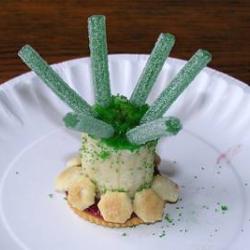Source Institutions
Source Institutions
Add to list Go to activity
Activity link broken? See if it's at the internet archive

In this activity, learners build one or more edible coral polyps and place them together to form a colony. Learners will review the differences between plants and animals, learn about the unique symbiotic relationship between corals and zooxanthellae, and discuss human impact on coral reefs. This detailed lesson guide includes key vocabulary, background information for educators, and wrap-up suggestions.
- 5 to 10 minutes
- 30 to 45 minutes
- $10 - $20 per group of students
- Ages 8 - 11
- Activity, Lesson/Lesson Plan, Model
- English
Quick Guide
Materials List (per group of students)
- paper towels/rag for clean-up
- plates
- toothpicks
- plastic straws
- sections of large bananas
- sour candy straws or twizzlers cut into 1 inch pieces
- sugar sprinkles (same color as the sour candy straws or twizzlers)
- jam
- round crackers
- oyster crackers
- transparency of coral polyp illustration
- coral polyp worksheets
- colored pencils, crayons, or markers
Subjects
-
Earth and Space Science
-
Earth Processes
- Weather and Climate
-
Earth Structure
- Oceans and Water
-
Earth Processes
-
Life Sciences
-
Diversity of Life
- Plants
- Animals
- Classification
-
Ecology
- Ecosystems
- Populations
- Human Impact
-
Diversity of Life
-
The Nature of Science
-
Science and Society
- Risks and Benefits
-
Science and Society
-
The Nature of Technology
-
Technology and Society
- Technology and the Environment
-
Technology and Society
Informal Categories
- Animals
- Food and Cooking
- Model Building
- Nature and Environment
Audience
To use this activity, learners need to:
- see
- see color
- read
- taste
- touch
Learning styles supported:
- Involves teamwork and communication skills
- Uses STEM to solve real-world problems
- Involves hands-on or lab activities
Other
This resource is part of:
Access Rights:
- Free access
By:
Rights:
- All rights reserved, California Academy of Sciences, 2008
